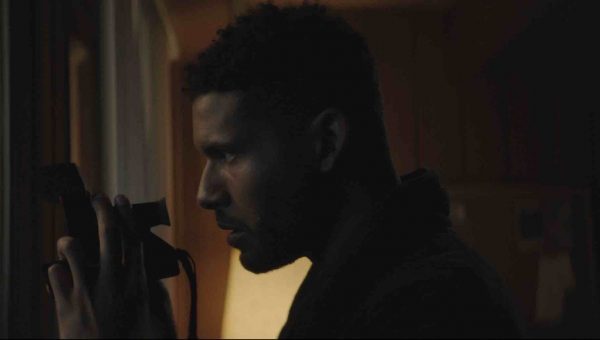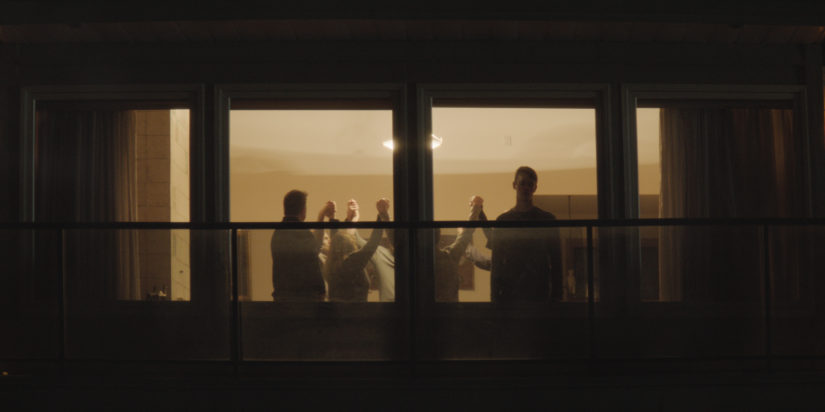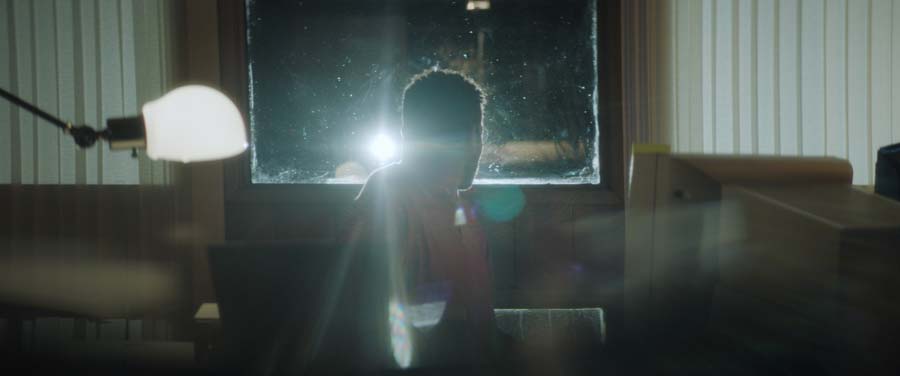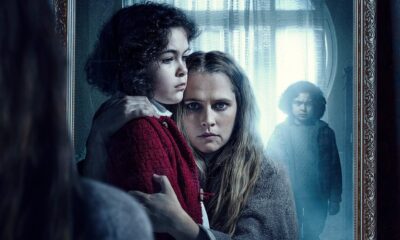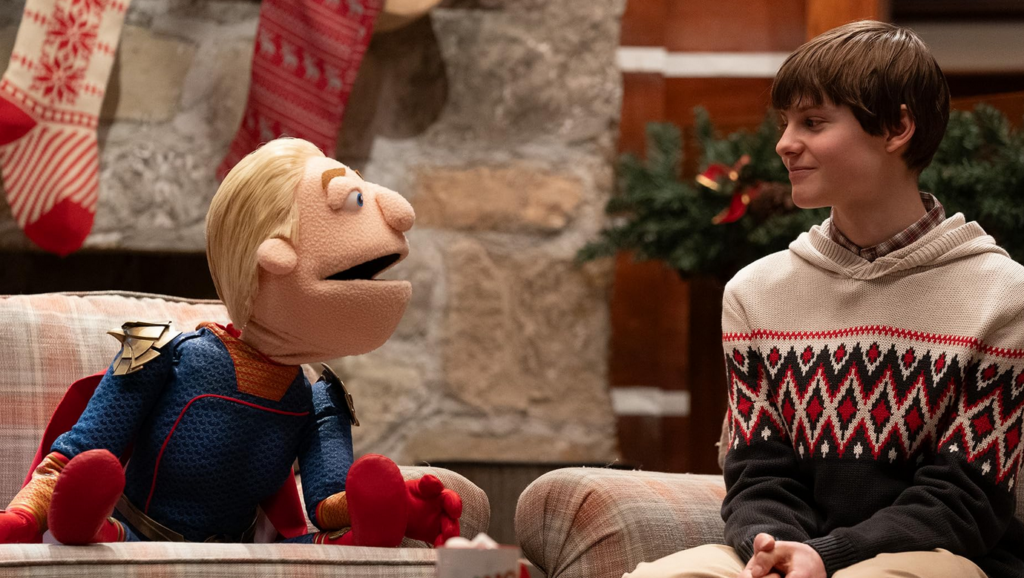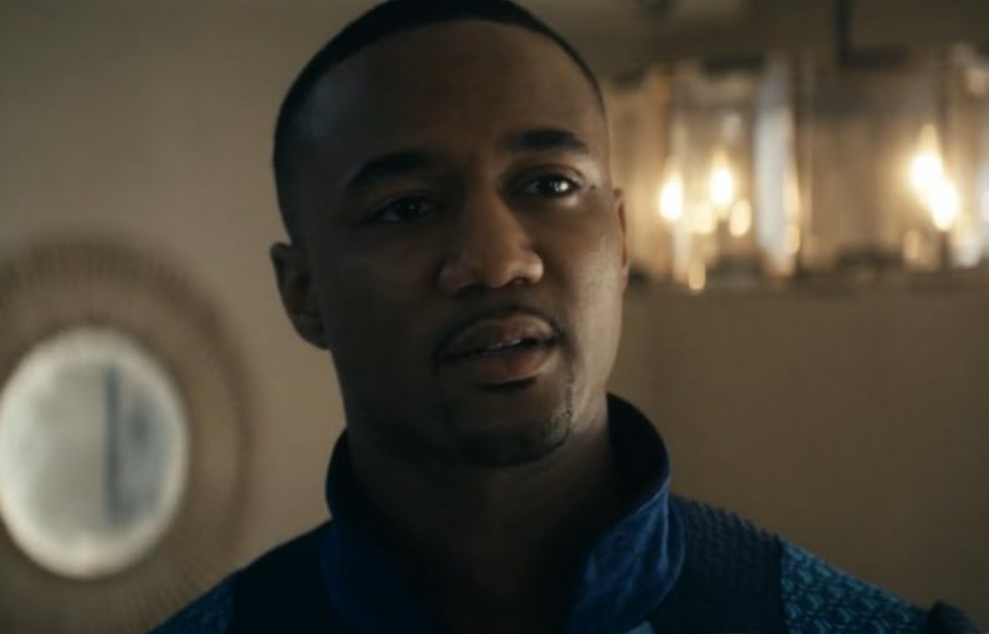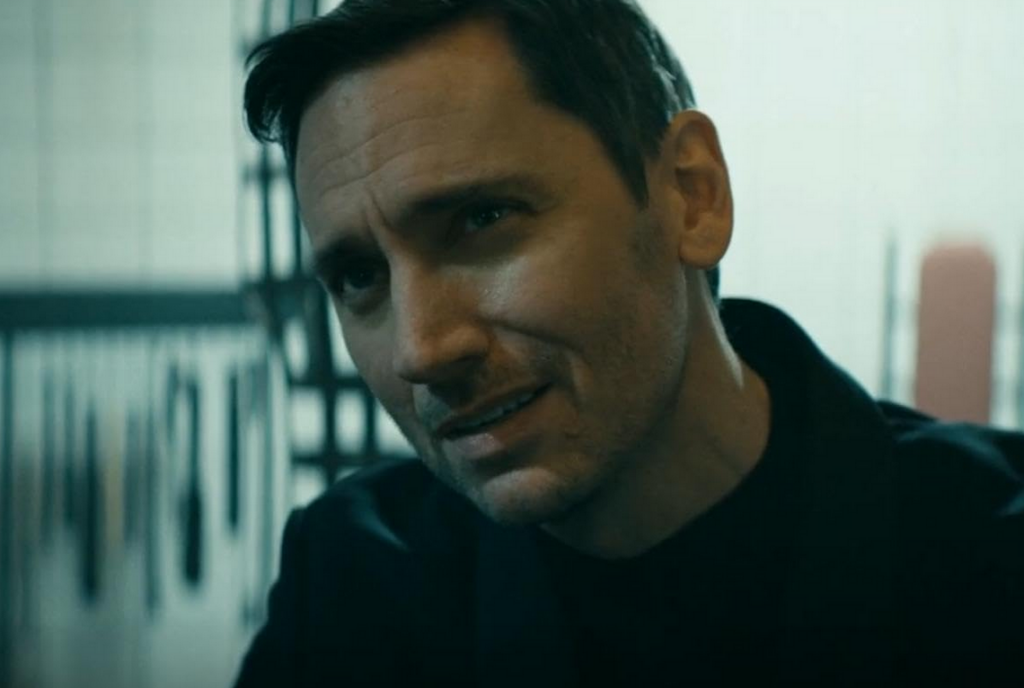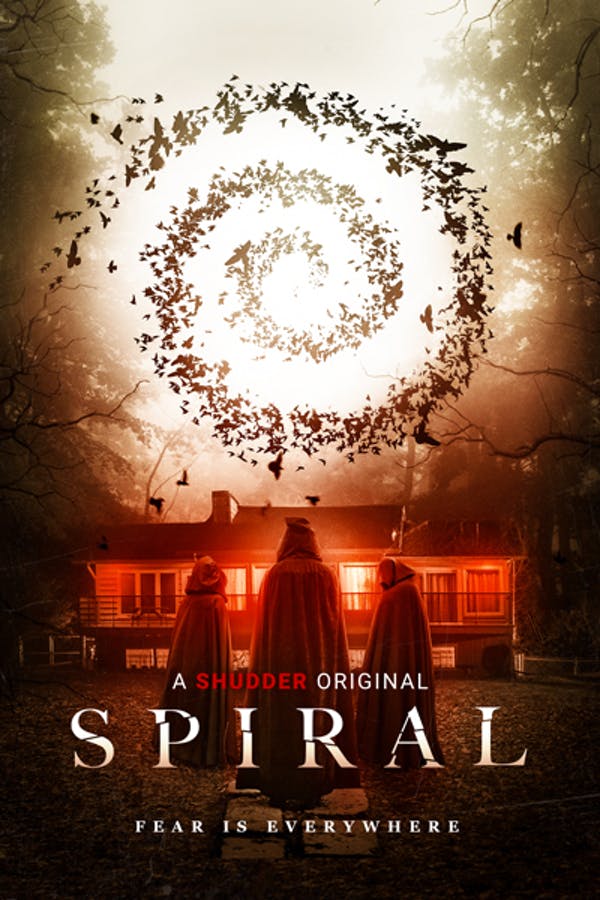
Spiral (2019) review: A gripping display of fear and the hate it breeds
More Videos
Published
4 years agoon
By
Rachel Roth
Very early in, it’s perceivably clear that Spiral is a story that a large portion of the audience will not appreciate. It might even elude them for there are moments where the terror comes off as uneventful or too tepid to go full third base unless you properly understand what it is that the central character is experiencing. Not that these viewers won’t be able to enjoy the film, only that they might look at the horror unfolding in Spiral and think nothing of it.
This difference in interpretation can be seen in the limited reviews for this film. Early discussions about Spiral from when it was released on Shudder in September, showed almost no middle ground between final verdicts. Certain groups of people which included women, minorities, and members of the LGBTQA+ community thought it was downright terrifying while others felt underwhelmed by what was presented.
Spiral confirms two things for me. One, ALL horror movie husbands are useless and two, nothing good ever happens in the suburbs. A perfectly tidy neighborhood filled with polished passive-aggressive white people that smell like snobs. Often unintnetional snobs but snobs nonetheless. That’s the first problem the characters make in Spiral. They move to the freaking suburbs.
Same-sex couple Malik (Jeffrey Bowyer-Chapman) and Aaron (Ari Cohen) move to a nice small city in the suburbs with Aaron’s daughter from a previous marriage, Kayla, your typical angsty teen. There is no big reason behind this move other than getting out of the noisy city. It’s quiet and supposedly, safe, but it doesn’t take long before weird things start happening because anyone who has ever seen a movie knows that in the suburbs, you’re neighbors are always up to no good.
On their first day there, Malik starts having problems with some of the neighbors as they appear rude in unduly polite ways. Then one day he comes home to find the slur “F****ts” written on their wall, and just like that, their peaceful, and shockingly spacious home becomes the setting for Malik’s worst nightmares. Things only get stranger when he finds several copies of a book with a spiral logo in the neighboring houses and when someone gives him a post-it note secretly numbered with dates. They’ve become targets in something sinister. Unfortunately, he’s the only one aware of these events. Aaron has no idea and refuses to take any of it seriously.
Spiral starts with a brief flashback of a hate crime in which a teenaged Malik and his boyfriend (not Aaron) are attacked by a group of homophobes. The memory appears repeatedly throughout the film and is the heart of Malik’s growing paranoia. He’s living in fear, waiting for the next attack, unraveling at the seams much to the confusion of the completely at ease Aaron. He doesn’t understand why his husband is so upset, or so afraid. The two analyze their surroundings in very different ways as Aaron is a seemingly well-off, middle-aged white man that has likely never experienced more than a few hateful words regarding his sexual orientation while Malik is a black man who has already suffered hate-induced violence.
Aaron doesn’t have a lot to do in the film. He’s absent for a large portion of it, and when he is present, it’s only to ask Malik why he can’t just get over his anxieties and go make friends with the neighbors. If only anxiety and PSTD were that easy to cure buddy.
At one point, he even makes the comment, “You know what people do in the suburbs?” he asks “they leave their doors unlocked.” Which is honestly one of the dumbest things I’ve ever heard. This film is not set in the 50s when the suburbs were at peak power. Spiral is set in 1995, a time when people should have been most definitely locking their doors! Anyone who trusts their community enough to sleep with the door unlocked is someone who has likely lived a sheltered existence, which I’m sure is exactly what the film is trying to say about Aaron. Being, not only a black man but also a gay man, Malik feels the pressure of conforming to “acceptable” society that Aaron is blind to.
Spiral isn’t all social commentary though. There is something going on in town. What may or may not be a cult is living next door and they’ve got their eyes set on Malik, or do they? For the first half, Spiral attempts its hand at being a psychological thriller that wants you to question Malik’s sanity. The biggest problem with that is the film immediately gives away the answer. As Malik is slowly losing his marbles, there are multiple shots of people in hoods watching the house from the outside.
As good as Spiral is, if it had kept the question of insanity more prominent I feel that it would have resulted in a more impactful finale. It gives away part of the mystery a bit too soon. Knowing early on that Malik is right and that the neighbors are up to something, changes the viewing experience. It slowly turns from a study of fear, trauma, paranoia, and prejudices into a guessing game about the neighbors. All those themes remain strong though, coming back big in the end.
Final Verdict
Spiral is Get Out meets IT, with an end that pulls a Sinister. (Sorry, I just love name dropping movies). It is brutally honest when it holds up that mirror to the audience, a rigid atmosphere that keeps you tense and a slow buildup of poking at cultural prejudices like poking at a water balloon. Soon everything’s gonna pop. There are two monsters in this film, the actual villains and the fear they exploit. Those who’ve targeted Malik and his family have no personal issues with either of them, but they need to use human nature to their advantage, and fear is a part of human nature. Where there is prejudice, they can thrive.
Spiral is streaming now on Shudder.
 (3.5 / 5)
(3.5 / 5)
All photos are property of Hadron Films and Digital Interference Productions
Related posts:
- Five tales of horror are dished out in the unforgettable ‘ The Mortuary Collection’
- ‘The Pale Door’ review: A decent western with a major witch problem
- Spree review: Joe Keery shines in this generation’s version of American Psycho
- ‘Castle Freak’ is a nutty but strangely good reimagining of Stuart Gordon’s classic.
Rachel Roth is a writer who lives in South Florida. She has a degree in Writing Studies and a Certificate in Creative Writing, her work has appeared in several literary journals and anthologies. @WinterGreenRoth

You may like
We have come now to the finale of season four of The Boys. And while it didn’t have the literal blood fireworks I wanted, someone did get ripped in half in the air. So, that’s pretty close.
As a note, I will try to avoid spoilers as much as possible. This ending was a hell of a gut punch that should be experienced as blindly as possible. That being said, I will not be able to avoid spoilers and still give a full legitimate review. Proceed at your own risk.
The story
The main storyline for this episode is the attempted assassination of President-Elect Robert Singer. The Boys join forces with the Secret Service to protect him. But, as we learned last episode, Annie has been replaced with a shapeshifter. A shapeshifter that was welcome not just into Hughie’s anus, but into the protective bunker in which the President-Elect is hiding.
What worked
The first thing I want to discuss about this episode is the ending. But we need to do this carefully.
The important thing here is that the ending breaks your heart on so many levels. So many terrible things are happening to characters that it’s almost hard to keep track. And each moment is significant to each character.
I cannot give a specific example. But no matter who your favorite character is, you’re going to weep for them.
Unless your favorite character is Sage. And this is the next thing that made this episode so fantastic.
I don’t think I’m spoiling anything to say that Sage’s plans worked out exactly as she wanted them to. And she got exactly what she wanted.
What she wanted wasn’t power. It wasn’t money or fame or vengeance. It wasn’t to win the love of anyone. She just wanted to see if she could do it.
That is a terrific, terrifying motivation! Because all she wants is to play a massive game of chess with people as pieces. She doesn’t care about anyone. She just wants to see how many people she can manipulate. She just wants to set things on fire to see if she can.
Fantastic. A plus villain work.
The next thing I want to discuss is a cornerstone of the whole series.
The morality of The Boys shifts through the series. While it’s very much a battle to save the world from overpowered super monsters, it’s also a battle for the souls of our real heroes. And in that battle, there are two warring factors. We have Hughie, always trying to bring everyone up to a better level. And we have Butcher, who has no problem at all hitting rock bottom with a shovel in hand to do some more digging.
In this episode, we saw almost every member of The Boys challenged. Will they rise to their higher angels, or sink with their demons?
On a similar note, I am so glad that the writers kind of addressed my issues with Annie. They did this by having the shapeshifter get right into her face and accuse her of thinking that she’s better than everyone.
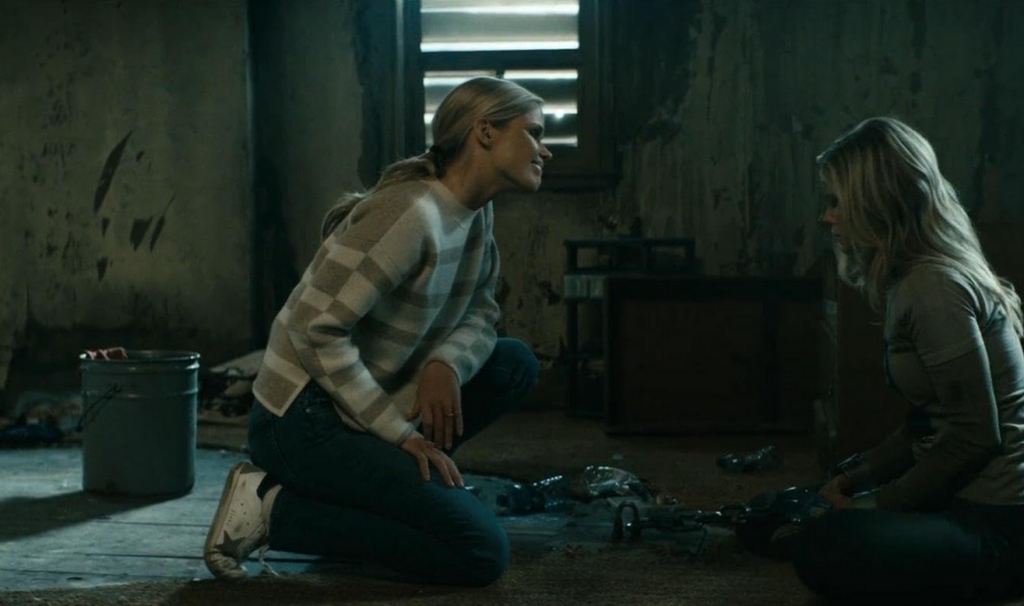
While that was devastating for the character, it was a little cathartic for those of us who felt like Annie was a little too good of a good guy.
What didn’t work
This is a small matter, but it is an issue that I want to address. After Annie finds out that Hughie slept with her doppelganger, she is furious at him.
In addition to this being unfair, it’s also a very cliche element to add. In almost every instance of a lookalike in fiction, there’s a moment where the love interest of the victim is fooled. Or almost fooled. And it’s always the same fight. It’s just played out and predictable. I’m just glad that it didn’t last very long.
Now that we’ve come to the end of the season, I can officially say that it was amazing. The story was deep and rich. The special effects were a stomach-turning good time. The character development was spot-on and satisfying. And, of course, it left me just about gagging to see what happens next. Unfortunately, it looks like we’ll have a bit of a wait. Because as of right now, the fifth season isn’t expected until 2026.

We’ve reached the second to last episode of The Boys, season four. And, as is appropriate for the penultimate episode of any show, things have to get a lot worse before they can get better.
Let’s discuss.
The story
Christmas is coming, and the whole world is getting ready. Ryan, despite being very clear that he didn’t want to appear on any TV shows or movies, has been strong-armed into participating in a Vought puppet Christmas special. He draws the line, though, when asked to sing about turning one’s parents in if they start talking about woke things.
Meanwhile, The Boys are trying to keep each other together. Butcher decides to take Sameer to the rest of the team. He also gets Frenchie out of prison, hoping they can make the Sup virus necessary to finally take down Homelander. Instead, this decision means disaster for one member of the team.
What worked
I first want to talk about Ryan’s speech near the end of the episode. Because it was exactly the moral of this whole story.
Ryan’s dad is a monster. His stepdad is also kind of a monster. But Ryan is a good kid. He cares about people, about family. And while he loves Homelander and Butcher, he doesn’t want to be like them.
Even better, this speech sounded like something a kid would say. Ryan didn’t open his mouth and start sounding like a college student all of a sudden. He sounds like a kid who misses his mom and wants to live up to the good standards she set for him. And I think that’s terrific.
Speaking of Homelander, he shot himself in the foot in this episode. I said earlier in the season that his hubris was going to be his downfall, and I was right. Without Sage, he just has the same weaknesses he’s always had. He’s going to fail because he just isn’t clever enough or patient enough to succeed.
Without Sage, I think a win is in the bag for The Boys. This isn’t to say that Homelander by himself isn’t dangerous. It’s just that he’s more like a wildfire than a controlled burn. He’s going to cause a lot of damage, but not get anything he wants out of it.
More’s the pity for him and everyone else who has to share his world.
Finally, I am thrilled with A-Train’s redemption story. I love that he wants to be a good person not to save himself, but to be a good person. His honest, pure and warm reaction to that little kid smiling at him in the last episode was heartwarming. It changed him in a moment, bringing to light a goodness that he’s been keeping under wraps for a long time.
This, along with Ryan’s courageous speech, proves once again what The Boys does so well. Yes, it’s gruesome. Yes, there’s blood and balls and batshit events. Yes, someone occasionally gets ripped in half. But there is a true human goodness in the story. One that we catch glimpses of. There are good people among the monsters. There is hope for redemption.
What didn’t work
Of course, so few things in this life are perfect, and this episode was no exception. For instance, I was irritated by the insinuation that Butcher cheated on his wife.
That just doesn’t make any sense. We’ve seen flashbacks of Billy and Becca. They were happy. He was happy. He was head over heels for her. And I don’t think it’s realistic or necessary for the character to throw in that he cheated. It does nothing to add to the story, it’s just a weird and offputting moment.
Doesn’t Butcher have enough to hate about himself? Can’t we just give him that at least he was a good husband?
Finally, I kind of hate that we ended up with Annie being caught. It’s just cliche, which is something I don’t normally say about this show. It feels lazy unless they do something very clever with it in the last episode. Which, I suppose, they might.
Next up is the season finale. And with this season being as insane as it has been, I’m expecting nothing short of bloody fireworks. And I mean literal fireworks of blood. At this point, would it surprise anyone?
 (4 / 5)
(4 / 5)
Episode six of The Boys was one of the most surprising episodes of the series so far. And that is certainly saying something. Because this season has so far been bonkers.
The story
Our episode today revolves around a party at Tek Knight’s lovely mansion. Yes, it does look just like Wayne Manor.
The Boys know that Tek Knight is working with Homelander on something, but they don’t know the details. So they decide to send Hughie in to bug the mansion.
Because that’s worked so well the other two times he’s tried to hide a bug!
It should surprise no one that this time goes no better. Hughie finds himself in Tek Knight’s basement. And by that I mean his BDSM dungeon.
Meanwhile, the party upstairs is no less disturbing. Homelander and Sage are trying to convince some well-off political donors to support a cue after the election. When pressed for details on his plan, Homelander freezes. He looks to Sage for help, but she wasn’t recently shot in the head and still in the junk food stage of her healing.
Fortunately, or unfortunately depending on your point of view, Neuman jumps in and saves the day.
What works
If I’m going to say one thing about this episode, it didn’t hold back at all. I didn’t expect them to show a character masturbating, sitting their bare behind on a cake, or spraying breastmilk into someone’s face. But every time I thought they’d cut the scene and let something be left to our imagination, they did not do that.
This is a dangerous move. Whenever you show the monster, you run the risk of them not being scary enough, or gross enough. As Stephen King says in Danse Macabre, to leave this sort of thing to the imagination if the reader makes things so much worse. So when they finally experience the monster, they might say that this isn’t so bad. It could have been so much worse.
But in this case, they managed to avoid that by making the scenes, especially the ones in Tek Knight’s dungeon, so much worse than I imagined it would be.
What doesn’t work
While this was a deeply disturbing episode in many ways, there was one really innocent and sweet moment.
And yes, I did have a problem with it.
Confronted by Firecracker, Annie decides to apologize for spreading rumors about her when they were kids. She tells her that she is genuinely sorry.
And I believe her. I don’t think Firecracker did, but I did.
So why is this an issue? Because I’m starting to think that Annie is maybe too nice. She is too good.
I know that Annie is our good guy. But every one of the other good guys has flaws. Hughie let his pride get in the way and took Temp V. MM hid himself from his daughter instead of teaching her to work through her emotions. Kimiko is far too closed off and has a hard time trusting others. Frenchie numbs himself with drugs. And well, what hasn’t Butcher done?
It is unrealistic that Annie is just so kind and so flawless. We all have shadows in our personalities. We all have weaknesses, we all mess up. We all do things we wish we could take back. The fact that Annie doesn’t seem to have anything like that is not just unrealistic. It’s infantilizing.
Give her some deep dark secrets. Give her something real to regret.
This was a shocking episode, even for someone fairly jaded like me. I wasn’t expecting the sort of weird sexual depravity, though I guess maybe I should have seen it coming. It was dark, upsetting, tense, and funny as hell. And with just two episodes left in the season, I can imagine the stakes are only going to get higher.
 (4 / 5)
(4 / 5)
By the way, if you like my writing you can get my short story, Man In The Woods, on Smashwords and Amazon.

